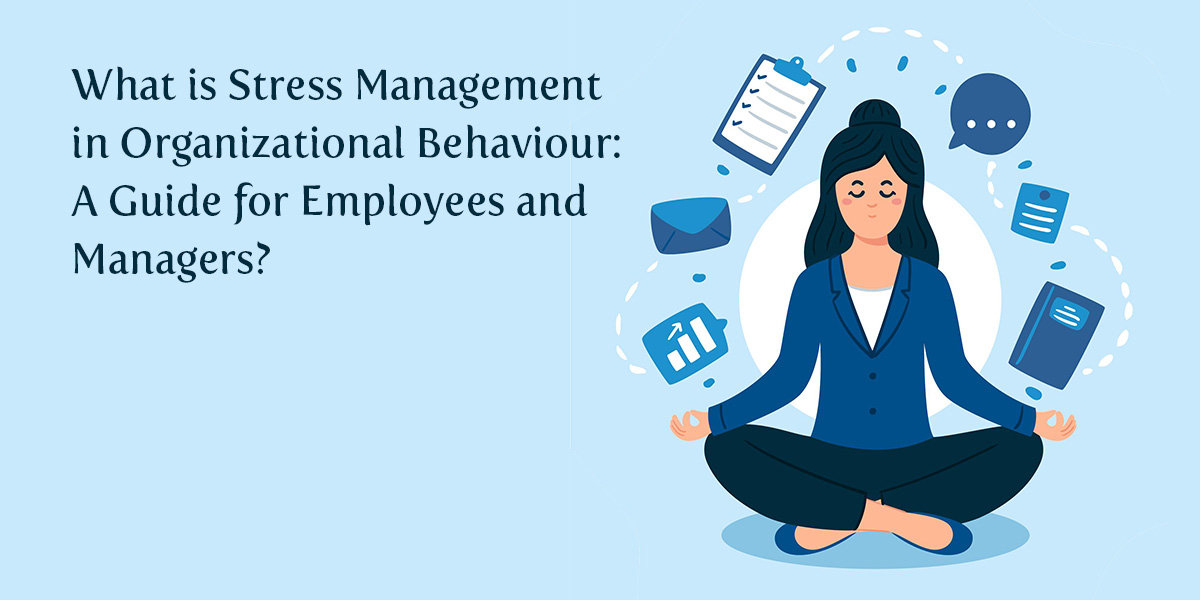Stress Management Techniques in Organizational Behaviour
Stress management is a pivotal component in organizational behavior. In today's demanding work environments, it is essential for organizations to adopt effective stress management techniques to enhance employee well-being, productivity, and overall organizational efficiency. This detailed guide explores comprehensive stress management strategies tailored for organizational settings, aiming to boost employee performance and foster a healthier work culture.
Understanding Stress in Organizational Behavior
Identifying Stressors in the Workplace
Stressors are factors that contribute to employee stress. Identifying these stressors is the first step in managing them effectively:
High Workload: Excessive workloads and tight deadlines often lead to increased stress levels among employees. High demands can overwhelm staff, resulting in decreased productivity and job satisfaction.
Role Ambiguity: Unclear job roles and expectations can cause anxiety. When employees are unsure about their responsibilities, it can lead to confusion and stress.
Interpersonal Conflicts: Conflicts with colleagues or supervisors can create a stressful work environment. Poor communication and unresolved disputes contribute significantly to workplace stress.
Work-Life Imbalance: Difficulty balancing work responsibilities with personal life can lead to burnout. Employees struggling with this balance may experience heightened stress and disengagement.
Impact of Stress on Organizational Performance
Stress affects various aspects of organizational performance, including:
Decreased Productivity: Stress impairs concentration and decision-making, leading to reduced productivity. Employees under stress may struggle to meet deadlines and maintain performance levels.
Increased Absenteeism: Chronic stress can result in health issues, leading to higher absenteeism rates. Frequent absences disrupt workflow and impact team performance.
Higher Turnover Rates: Persistent stress can lead to job dissatisfaction and burnout, increasing employee turnover. High turnover rates can be costly and affect organizational stability.
Diminished Employee Engagement: Stress can erode employee motivation and engagement. Disengaged employees are less likely to contribute positively to organizational goals.
Effective Stress Management Techniques
Implementing effective stress management techniques is crucial for creating a supportive work environment. Here are some strategies to consider:
1. Establish Clear Expectations and Roles
Clarity in roles and expectations is essential for reducing stress. Implement the following practices:
Define Job Roles Clearly: Create detailed job descriptions outlining responsibilities and expectations. Clear role definitions help employees understand their duties and reduce ambiguity.
Set Realistic Goals: Establish achievable goals and deadlines. Setting realistic expectations prevents overwhelming employees and maintains manageable workloads.
2. Promote Work-Life Balance
Encouraging a healthy work-life balance is crucial for stress management. Consider these strategies:
Flexible Work Arrangements: Offer flexible working hours or remote work options. Flexibility allows employees to manage personal and professional responsibilities effectively.
Encourage Time Off: Promote the use of vacation days and personal time. Regular breaks and time off help prevent burnout and maintain employee well-being.
3. Foster a Supportive Work Environment
Creating a positive and supportive work culture can significantly reduce stress. Implement the following practices:
Open Communication: Foster transparent communication between employees and management. Regular feedback and open discussions help address concerns and prevent misunderstandings.
Conflict Resolution Mechanisms: Implement procedures for resolving interpersonal conflicts. Training in mediation and conflict resolution can help address disputes and maintain a harmonious work environment.
4. Implement Stress Reduction Programs
Organize programs focused on stress reduction to provide employees with effective coping tools:
Employee Assistance Programs (EAPs): Offer access to counseling and support services through EAPs. These programs provide professional assistance for personal and work-related issues.
Stress Management Workshops: Conduct workshops on techniques such as mindfulness, time management, and relaxation exercises. Educating employees on stress management enhances their ability to handle stress effectively.
5. Encourage Physical Activity
Promote physical activity as a key component of stress management:
On-Site Fitness Facilities: Provide access to fitness facilities or gym memberships. Regular exercise helps alleviate stress and improves overall health.
Active Breaks: Encourage short, active breaks during the workday. Simple activities like stretching or walking can reduce stress and boost energy levels.
6. Promote Healthy Eating
A balanced diet supports stress management. Consider the following:
Healthy Snacks: Offer nutritious snack options in the workplace. Providing healthy food choices helps maintain energy levels and reduces stress.
Nutritional Education: Educate employees about the benefits of a balanced diet. Workshops or resources on nutrition support healthier dietary choices.
7. Support Mental Health Initiatives
Addressing mental health is crucial for effective stress management:
Mental Health Awareness: Raise awareness about mental health issues and reduce stigma. Creating an environment where mental health is openly discussed encourages employees to seek help when needed.
Access to Professional Support: Provide access to mental health professionals and resources. Ensuring employees have support for mental health challenges enhances overall well-being.
8. Encourage Work Autonomy
Allowing employees to have a say in their work can reduce stress:
Empowerment: Give employees autonomy over their tasks and projects. Empowering staff to make decisions and manage their work enhances job satisfaction and reduces stress.
Recognition and Rewards: Recognize and reward employees for their contributions. Positive reinforcement boosts morale and reduces stress.

